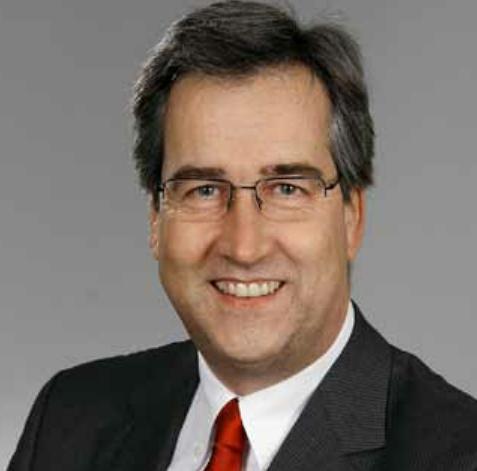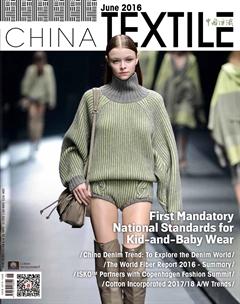An Interview with Mr.Andreas W.Engelhardt

Editors Note:
The world textile yearbook, known as The Fiber Year, is instrumental in keeping the world textile players informed of the latest developments, on-going performance and future projections in fiber-to-fashion industries. The new publication is just off the press and can be commercially available in both electronic and paper-print versions. China Textile editor has been in communication with Mr. Andreas W. Engelhardt General Manager of The Fiber Year GmbH, also author of the world fiber almanac, for an interview that, hopefully, is interesting to our readers.
Q: Mr. Engelhardt, we know the Fiber Year 2016 is a great accomplishment that comes out from your independent research and diligent work just as it has been for the past years since you started to run your own company to relay the torchlight of the history in publishing this almanac. Please say something about this story.
A: Basic idea of reporting production data looks back on a much longer history. It has been initiated by former world market leader in manmade fibers, Vereinigte Glanzstoff-Fabriken AG. Dr. Vits, chairman of the board between 1940 and 1969, informed at press conferences about the status of the world manmade fiber industry. At a presentation on February 8, 1966 he expressed that this industry would enjoy dynamic growth. A truly appropriate evaluation as manmade fiber output back then was 5.5 million tonnes versus more than 65 million at present.
Q: Ever since you started to present the fiber yearbook by your own company in 2011, are there any changes that you brought about in the annual print?
A: Yes. In fact, the scope of this yearbook has been continuously enriched by integrating natural fi- bers and feedstock markets for main fiber types with the target to deliver an objective survey on the world fiber and nonwovens industry, their latest trends and most current trade flows. Doubling trading activities by value since the beginning of the century necessitate an intense appraisal along the textile value chain as globalization further advances. Hence, the enlarged scope comprises data for major markets about the relation between available fiber material and volume for subsequent processing.
Q: The enlarged scope of this report must have consumed a lot more time and efforts in the research process, even change your way of collecting data as opposed to the conventionality?
A: Indeed, the broad scope of industries, markets and applications not only necessitates compiling as many official data as possible. It further requires reviewing the data received and making plausibility checks whenever advisable.
A further essential part involves talks with industry experts in each and every segment to make sure the data plausibility checks are meaningful before finally validating market size, trend of the market and prospective orientation. Inter-fiber competition is sufficiently known, thus, comprehensive coverage of the world fiber markets in an enlarged scope of the year report is a strategic benefit.
Furthermore, the linkage to upstream raw material markets is instrumental to get an early indication about future surplus or deficit along the corresponding chain as conversion time of petrochemical projects is much longer and involves much higher investments as the erection of spinning lines and subsequent processing equipment.
At this point we would like to express our gratitude to all who have made a valuable contribution by providing articles, supporting us in data collection and exchanging views.
Q: The report is enhanced in both size and depth to judge by this standard. You want to share your views with our readers in this respect?
A: Latest enhancement includes an analysis for major markets referring to the available fiber material and volume for subsequent processing. This leads to the introduction of a new key figure “Fabric Making Potential”.
The report covers a world fiber market in excess of 95 million tonnes from the large-scale polyester sector to booming carbon fibers, depressed acetate tow and cotton which is predicted to witness its steepest drop in production in forty years. This broad approach is of strategic benefit and delivers prospective orientation by taking into consideration inter-fiber competition.
Fiber prices have marked new long-term lows in several segments as a consequence of continued slowing of demand at retail stage, crude oil price deterioration from oversupply, massive investments in polyester feedstocks, persistent excess capacity in a number of manmade fiber markets and high fiber inventories.
Q: Thank you for your in-depth analysis for the fiber material markets, volume of subsequent processing and your new introduction of a new key figure”Fabric Making Potential”, which is a new diversion of trade and investment if the trend goes on as projected. Your report also touches upon international trend for subsequent processing. Does it have more ponderances in shaping trade and investment pattern?
A: The vast majority of countries have suffered from a decreasing export value in textiles and apparel with just a few exceptions like Bangladesh, Cambodia, Myanmar and Vietnam. In the case of Vietnam, the country faces a boom in the textile sector with exports almost tripling in six years. Much of this growth may be attributed to politics as negotiations for a free trade agreement with the EU have been concluded in December 2015 while an appropriate agreement with Korea just went into effect at the time. In addition, the Trans-Pacific Partnership (TPP) agreement, signed in February 2016, will reduce average tax on Vietnamese garments from around 18% to zero for exports to member countries. This will facilitate shipments into a region with more than 740 million consumers by 2020.
Q: We would like to have your summary of this new report as part of Whos Who column in China Textile (June Edition). Thank you for your contribution. Is there anything you want to emphasize before we conclude this interview?
A: This textile yearbook is now the 16th edition thanks to the support of Lenzing Group. All market data, however, are result of the independent research by The Fiber Year GmbH. Thus, statements and conclusions in the report do not necessarily reflect the assessment of the Lenzing Group.
We do hope this textile yearbook will be useful to conduct your business. This survey hopefully explains global industry trends, market developments and fiber competition in a way that future investment decisions may return to the principles of market economy.

